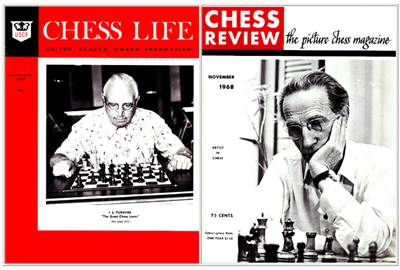November 1968 'On the Cover'
Chess magazine covers aren't reserved exclusively for World Champions and top grandmasters. Sometimes they feature prominent members of the B-team. Here we have two of them for the same month.

Left: 'I.S. Turover, "The Great Chess Lover"'
Right: 'Artist in Chess'
Chess Life
Last month's October 1968 'On the Cover', featured a report by TD George Koltanowski on the 1968 U.S. Open. This month's cover led to a continuation of that report.
Attending the U.S. Open at Snowmass from the start to the bitter end was none other than the "Grand old Man" (if I said "young" I would be more correct), I.S. Turover of Washington, D.C. The septuagenarian was in the thick of things, no matter at what time the games were adjourned in the evening or continued in the morning. And when the masters assembled at the special dinner given by I.S., we heard wonderful tales of the chess past from E. Schuyler Jackson of New York and from I.S. himself. Here's one of them:
The tale, omitted here, was a story about Turover meeting Alekhine and his wife.
I.S. Turover was born in the same city as M. Najdorf, in [Warsaw] Poland, and came to New York in 1912, where he played in his first tournament in 1913. At 17, he won the Championship of Washington, D.C. He won it altogether three times, gaining permanent possession of the Washington Post Trophy, retiring undefeated in 1928!
In business, he started as a jack-of-all-trades, and then started making good in the lumber business. Although he was blessed with success, he never forgot his great love: chess. Though well known in all charitable and civic circles as a great donor and supporter, he also supports chess. Only recently he participated in the sponsorship of Bobby Fischer's trip to the Natanya [Netanya] tournament in Israel, and he accompanied Bobby to the event.
Chess Review
Marcel Duchamp died at 81 last October 1st, in Paris. In the art world, he became the "stormy petrel," much as Nimzovich had been in chess, taking a leading part in rebellion against established conventions and beliefs and in promoting the skeptical school of Dadaism. As of today, however, he holds a revered place as a prophet of and leader in most or the recent experiments in art forms. In consequence, his obituaries have been impressive and featured as front-page news in the papers.
Most of the obituaries carry Duchamp's half-serious statement that he gave up painting for chess. In chess, he was a quiet and genial figure, playing a strong game and active mainly in New York state chess circles and in the London Terrace Chess Club in New York city. Duchamp was a Frenchman, became an American citizen; but, in art and in chess, he was truly international. • Photo by courtesy of the New York Times
This Chess Review would be the first issue of the last 12 months of the publication's existence.




No comments:
Post a Comment